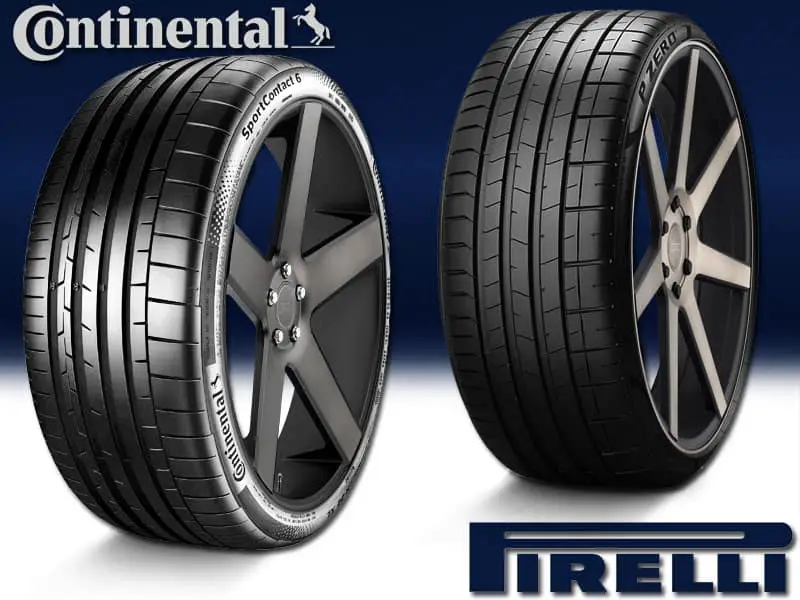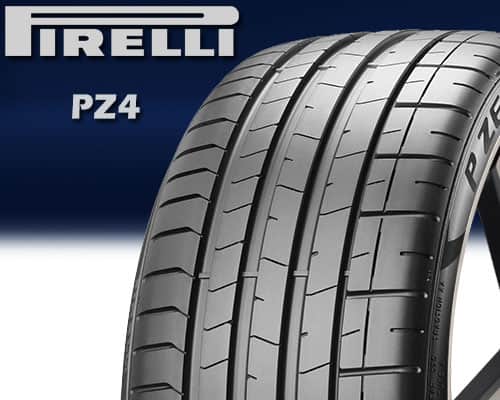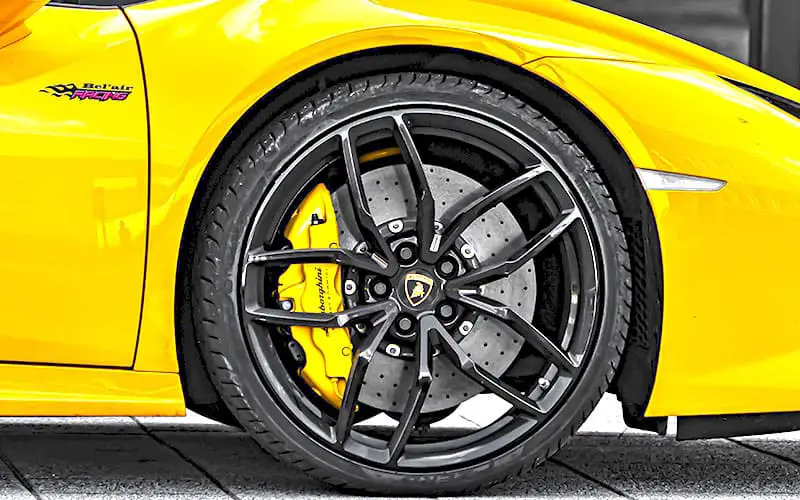Both are max performance summer tires that are designed to provide better performance and cornering stability in the hot and humid summer climate. PZ4, in comparison, consists of a much higher void ratio, allowing the tire to resist hydroplaning and provide better cornering abilities in wet conditions due to the presence of numerous sipes.
Contact 6, on the other hand, consists of comparatively lower spaced tread columns, allowing it to perform well on-road in terms of dry and wet grip and provides improved steering control in dry conditions as well.

Contact 6 overall performance is better while PZ4 due to its lower rolling resistance has slightly higher durability when compared with its competitor.
Table of Contents
Comparing Pirelli PZ4 with Continental Sport Contact 6
Pirelli P zero PZ4

Continental Sport Contact 6


Vs

PZ4 consists of an asymmetrical pattern of tread blocks having 4 circumferential grooves and comprising of relatively higher void ratio. The higher void ratio allows a lower contact patch between the tread and the road. The relatively high contact patch with marginally unoptimized shoulder makes the tire perform slightly lesser than its rival for dry and wet road grip.

However, its performance for wet conditions handling is way better due to the presence of more sipes on its shoulder. The major advantage of PZ4 (over its counterpart) is its high hydroplaning resistance because of its higher void ratio. The wearing of treads in the tire is lower due to the low rolling resistance (due to lower contact patch), making the tire more durable as well as increasing its mileage.
Sport 6 also features an asymmetrical design of tread blocks along with a powerful outboard shoulder with narrowly spaced intermediate rib for providing more stability. Its contact patch is high due to the presence of a lower void ratio. The continuous rib provides solid contact with the ground without any interruptions, causing the tire to enhance its grip for dry handling. The comparatively lesser sipes on shoulder design hinder the tire to perform well while wet handling. Its performance in hydroplaning conditions also lacks in comparison to its peer due to the presence of slightly narrow grooves and absence of decent sipes. Its rolling resistance is high due to a higher contact patch which further increases its treadwear, decreasing its mileage and durability as well.
Road Grip Comparison
The grip of any tire is directly related to the contact patch of the tire. Higher the contact patch more will be the grip of a tire and vice versa. Since PZ4 has comparatively wider grooves, therefore, has a lower grip than its rival. The braking distance (distance covered before complete stopping of the tire) determines the grip of any tire, the better the tire grip, the sooner it will stop. PZ4 has a braking distance of 115.15 feet which is good but is lower than its counterpart. The wet grip of the tire along with the contact patch also depends on sipes. Although the contact patch of the PZ4 tire is on the lower side when compared to its competitor, the presence of more sipes does help it to provide a good grip during wet conditions. The wet braking distance of the tire is 153.2 feet which is comparatively lower than its competitor.
On the other hand, the lower contact patch of Sport 6 does provide better gripping to the tire than its counterpart. The dry braking distance of the tire is 110.8 feet, providing it a slight advantage over its rival to have a better grip on a dry road. In short, both tires are good in dry conditions, but Sport 6 is slightly ahead. The presence of deeper sipes also gives them an upper hand in wet conditions as well. Its wet braking distance is 91.2 feet, way better than its competitor. This makes the tire one of the best in wet conditions among all its competitors.
Handling Comparison of the tires
When handling of any tire is discussed, shoulders play a very vital role. In the case of PZ4, the tire consists of wide-open shoulders with large voids, therefore, offers a lower contact patch while steering the tire than its peer, reducing its dry handling. wet handling speed is better due to the presence of a higher number of sipes, hence, providing higher handling stability on wet roads.
Sport 6 on the other hand, consists of a slightly more close and more compact shoulders design than PZ4. The greater contact patch provides higher handling stability. Therefore, it has a comparatively high handling speed for dry roads. When considering wet handling, the absence of decent sipes in its shoulder blocks hinders its ability to steer well on wet roads.
Comparison of Hydroplaning Resistance
Hydroplaning is a state in which the tires do not contact the surface due to the presence of water in between. This causes the tire to lose grip with the ground, thus, increasing the chances of slippiness. The wide and deep grooves in PZ4 help the tire to pass out the water more conveniently than its competitor making it preferable to be used in such conditions.
In the case of the Sport 6 tire, due to the presence of narrow grooves, the grooves do not allow much n water to pass through them, making it difficult for the tire to move forward smoothly thereby, increasing the chances of slippiness and accidents.
Comparison of Rolling Resistance
The rolling resistance of the tire is directly proportional to the contact patch. The higher the contact patch, the higher will be rolling resistance and vice versa. In the case of PZ4, the slightly wider grooves reduce the contact patch which reduces the friction between the tire and road. Consequently, less force is required to overcome this friction which further leads to lower rolling resistance as compared to its counterpart.
While in Sport 6 tire, due to occupancy of less wide grooves the contact patch is relatively high which further increases the friction between road and tire. To overcome this high friction, a large amount of force is required, therefore, its rolling resistance is on the higher side as compared to the PZ4 tire.
Comfort and Noise Comparison
The presence of marginally wider grooves in PZ4 allows more molecules of air to be trapped inside the grooves. The striking of these particles in the back-and-forth direction produces noise. Thus, the PZ4 generates more noise than its rival.
The narrow grooves in Sport 6 in comparison, allow fewer particles of air to be captured inside the voids between the tread blocks. Fewer particles will generate lower noise when moving at a very high speed.
Durability and Treadwear Differences
The tread blocks of the PZ4 tire are developed with black carbon and a special silica compound to enhance its durability. Although its performance for dry and wet grip is lower than its peer, the lower contact patch due to the presence of wider grooves may give it an upper hand in the wearing of treads. Due to low rolling resistance, its treadwear is also low. It increases its durability and also provides greater mileage as well.
Sport 6 internal structure consists of two-ply rayon that supports two high tensile steel belts to increase both stability and grip. Besides having a better performance for dry handling and gripping, its durability is also low due to the higher wearing of its tread. because the higher contact patch allows more tread in contact with the ground, therefore, causing more wearing, thus, decreasing its durability and mileage.
Price Differences
PZ4 is highly-priced as compared to Sport 6 due to its better-built strength, high mileage, and high durability. Its performance for both dry and wet grip and handling is almost equal to Sport 6 along with better durability as well. Although Sport 6 overall performance is better than PZ4, it causes more wearing of tread, decreasing its durability and that’s why it’s a little cheaper.
Quick Summary
- Both PZ4 and Sport 6 are max-performance summer tires.
- Sport 6 has a comparatively higher dry and wet grip than PZ4.
- Compact and close shoulder enable Sport 6 to perform better for dry handling situations.
- PZ4 performance for wet handling situations is superior due to the higher number of grooves.
- PZ4 due to its wider grooves provides greater hydroplaning resistance.
- PZ4 has a better-built strength, more durability, and a high mileage than Sport 6.
- Although Sport 6 overall performance is better than PZ4, it is still cheaper than its competitor simply because of low mileage and durability.


